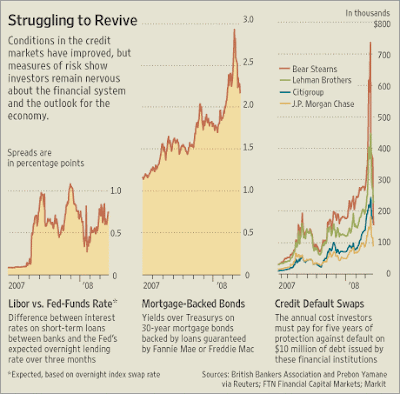Spreads between treasuries & MBSs
This may be a little technical for most folks but this article explains that the curretn spreads between US treasury bonds & mortgage-backed bonds (MBSs) are extremely high. If we get some confidence back in the credit markets we should see this spread narrow which would send mortgage rates lower.
From WSJ.com:
Bond, Loan Markets Remain Wary
Despite Fed’s Efforts,
Interest-Rate ‘Spreads’
Reflect Big Fear of Risk
By LIZ RAPPAPORT
March 27, 2008
The Federal Reserve’s efforts to heal broken credit markets have diminished worries about a big financial failure, but wariness about lending remains in bond and loan markets.
This wariness shows up in the movements of many interest rates and in a commonly watched measure of risk known as a spread. A bond’s spread is the difference between its interest rate and the interest rate on a relatively risk-free investment, like a Treasury bond or a Federal Reserve loan. When spreads get bigger, as they have in recent months, it shows that investors are reluctant to own anything but the safest investments.
In many markets, spreads have improved since the Fed’s actions of last week, but they remain elevated compared with a few months ago. Other measures of risk in credit markets, such as the cost of insuring bonds against default, have improved, particularly for bonds issued by financial institutions, but they aren’t out of the woods yet.
“There are still a lot of challenges looming,” says Kevin Flanagan, fixed-income strategist at Morgan Stanley.
Last week, the Fed helped to orchestrate the sale of Bear Stearns Cos. to J.P. Morgan Chase & Co. The Fed has also reduced its benchmark lending rate by three percentage points since September and created several borrowing facilities to address Wall Street’s short-term financing needs. But the root causes of the credit crisis — worries about mounting mortgage defaults and a desire among many investors and financial institutions to reduce their debt loads — still hang over the market.
As worries reached a crescendo nearly two weeks ago, spreads on everything from mortgage debt to short-term money-market loans between banks shot higher.
Consider interest rates on mortgage securities backed by government sponsored entities Fannie Mae and Freddie Mac. These bonds’ spreads relative to comparable Treasury bonds have narrowed after reaching 20-year highs March 6, a day after Carlyle Capital Corp., an investment fund, said it couldn’t meet cash demand from some bankers.
Since March 6, the average spread on a 30-year mortgage bond has fallen by 0.76 percentage point to 2.17% over Treasury bonds. Still, that spread was 1.14% over comparable Treasury bonds last June.
“It’s a start,” says Michael Schultz, portfolio manager at Summit investment Partners, which invests in mortgage- and asset-backed securities. “Until we have hit bottom in the housing market, you’re not going to get a major uptick.”
Mortgage-market spreads have moved nearly in tandem with other measures of risk, says Hans Mikkelsen, credit strategist at Banc of America Securities: “At the root of all that happening is the housing market and banks’ and brokers’ exposure to the housing market.”
In the derivatives market, where investors buy and sell protection against bond defaults, the cost of insuring against default by firms like Bear Stearns and Lehman Brothers has dropped since the Fed’s actions.
Investors can buy protection against a Lehman default on $10 million of bonds for almost half of last week’s price, at $231,543 annually from $447,515. The cost of such protection last year was just $29,261.
But this hasn’t dramatically changed the reluctance of banks to lend to each other. In short-term funding markets, spreads show that firms are still reluctant to part with their cash.
The spread between three-month Libor, or the London interbank offered rate, and the expected federal-funds rate over the next three months remains elevated. This spread shows the difference between what firms charge each other for short-term cash and what they expected to pay in the relatively risk-free overnight fed-funds market. The spread widens when banks are worried about short-term risks.
The spread rose to 0.65 percentage point Tuesday from 0.59 point Monday. It peaked in December at more than one full point. In normal times, it rarely surpasses 0.10 point.
The trouble has spread to corporations. Spreads on junk bonds have gone from record lows last summer, about 2.4 percentage points over comparable Treasury bonds, to about eight percentage points over, even though the rate of default remains near historic lows, according to Standard & Poor’s. While S&P believes defaults will rise to only 4.6% in 2008, others say the wide spreads in the junk-bond market reflect expectations for a deeper economic downturn.
